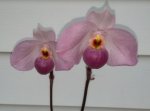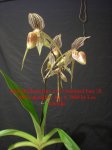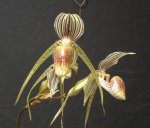Leo in N E Illinois
The Professor
- Messages
- 11,477
- Reaction score
- 23,796
- USDA Zone
- 5b
I had one or two requests to do some articles on raising orchids, so I thought I'd start a series of threads on different orchid topics. Please post your own photos, experiences or questions, dialog is the goal. The first thread started by @MACH5 has a nice discussion about how to raise Phalaenopsis (Phals) the orchid most commonly sold in grocery stores and box stores. Check it out if you are just getting into orchids. http://www.bonsainut.com/threads/winter-blues-and-yellows-and-pinks.21575/
Paphiopedilum is my personal favorite group of orchids. I started collecting Paphs in 1975, and still have one or two of the plants I picked up back then. They are generally easy to grow, tolerate occasional episodes of neglect if neglect is not repeated too often. They generally require bright shade, are perfect for growing under shop lights. Most will start blooming while still in a 3 inch diameter pot, most will be full sized mature plants in a 1 quart size pot, I use 4 x 4 x 5 inch pots for the majority of my larger growing Paphs. The shape of the bloom is exotic, the labellum of the flower has become a pouch, and the colors are usually not overly gaudy. Colors tend to be greens, browns, some white, pinks, with splashes of red, or purple, sometimes yellow, and often with black spots, a few are wine purple-red.
These are a couple I've had blooming over the last year or two. In the next post I'll describe my culture.
Paphiopedilum Ho Chi Min (delenatii x vietnamense) both parents of this hybrid occur only in Viet Nam
it is in a pot from the Yi Xing kilns, China, the pot is roughly 5 inches diameter x 6 inches tall. Flowers are roughly 4 inches across, this is a fairly old, specimen size plant. Colors look muted on the cell phone pictures. Below is a flash picture, in life the colors are between the 2 photos. Lovely soft pink. No fragrance, although one parent, Paph delenatii can be fragrant. Pretty easy to grow. This is a good example of the subgroup of Paphs called the Parvisepalum. The various subgroups (subgenera) tend to share growth habits, and cultural requirements. The Parvi's for short, are a favorite group of mine.


next is Paph Bel Royal (rothschildianum x kolopakingii) this one is a behemoth of a plant. Leaf span in the photo is roughly 48 inches from leaf tip to leaf tip. It is potted in a plastic 4 inch diameter x 6 inch tall tube I put holes into for drainage. This is a "first bloom seedling" only one growth. The plant is about 8 years from seed. This is an older photo, but it illustrates a "type", the multifloral Paph, where all flowers open at the same time. The subgroup is called Corypetalum or Anotopetalum, and includes the most spectacular of Paph orchids, Paph rothschildianum. Flower stem bends toward the camera, flowers are about 4 inches wide by 6 inches tall. In this group 3 to 7 blooms, opening simultaneously is normal. Colors are a tip off that in nature, the parent species are usually fly pollinated. Thankfully most do not use fragrance to attract the flies. Though the species kolopakingii does have a faint fragrance, like a diabetic goat pissed on it, sort of a urine and honey fragrance. There is a reason it is usually men who collect slipper orchids. Our noses don't work well.
Paph Bel Royal


More later, next post
Paphiopedilum is my personal favorite group of orchids. I started collecting Paphs in 1975, and still have one or two of the plants I picked up back then. They are generally easy to grow, tolerate occasional episodes of neglect if neglect is not repeated too often. They generally require bright shade, are perfect for growing under shop lights. Most will start blooming while still in a 3 inch diameter pot, most will be full sized mature plants in a 1 quart size pot, I use 4 x 4 x 5 inch pots for the majority of my larger growing Paphs. The shape of the bloom is exotic, the labellum of the flower has become a pouch, and the colors are usually not overly gaudy. Colors tend to be greens, browns, some white, pinks, with splashes of red, or purple, sometimes yellow, and often with black spots, a few are wine purple-red.
These are a couple I've had blooming over the last year or two. In the next post I'll describe my culture.
Paphiopedilum Ho Chi Min (delenatii x vietnamense) both parents of this hybrid occur only in Viet Nam
it is in a pot from the Yi Xing kilns, China, the pot is roughly 5 inches diameter x 6 inches tall. Flowers are roughly 4 inches across, this is a fairly old, specimen size plant. Colors look muted on the cell phone pictures. Below is a flash picture, in life the colors are between the 2 photos. Lovely soft pink. No fragrance, although one parent, Paph delenatii can be fragrant. Pretty easy to grow. This is a good example of the subgroup of Paphs called the Parvisepalum. The various subgroups (subgenera) tend to share growth habits, and cultural requirements. The Parvi's for short, are a favorite group of mine.


next is Paph Bel Royal (rothschildianum x kolopakingii) this one is a behemoth of a plant. Leaf span in the photo is roughly 48 inches from leaf tip to leaf tip. It is potted in a plastic 4 inch diameter x 6 inch tall tube I put holes into for drainage. This is a "first bloom seedling" only one growth. The plant is about 8 years from seed. This is an older photo, but it illustrates a "type", the multifloral Paph, where all flowers open at the same time. The subgroup is called Corypetalum or Anotopetalum, and includes the most spectacular of Paph orchids, Paph rothschildianum. Flower stem bends toward the camera, flowers are about 4 inches wide by 6 inches tall. In this group 3 to 7 blooms, opening simultaneously is normal. Colors are a tip off that in nature, the parent species are usually fly pollinated. Thankfully most do not use fragrance to attract the flies. Though the species kolopakingii does have a faint fragrance, like a diabetic goat pissed on it, sort of a urine and honey fragrance. There is a reason it is usually men who collect slipper orchids. Our noses don't work well.
Paph Bel Royal


More later, next post






